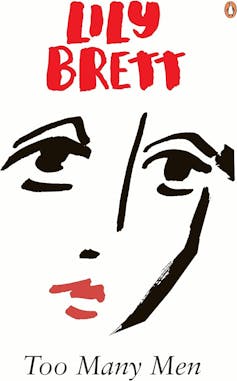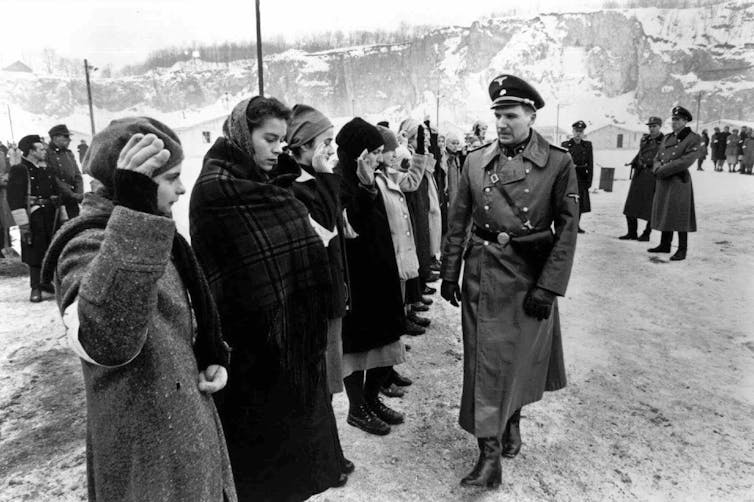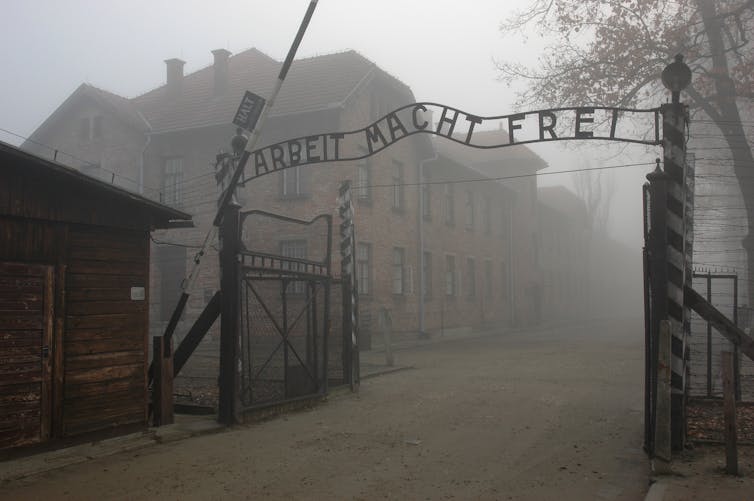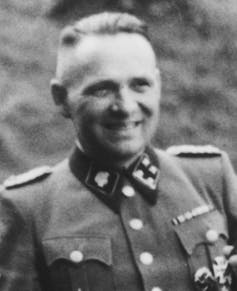Lily Brett’s acclaimed novel Too Many Men was published 25 years ago, in 1999. Next month, a feature film adaptation, Treasure, directed by Julia von Heinz and starring Lena Dunham and Stephen Fry, will screen in Australia.
The novel tells the story of a daughter of Holocaust survivors, 43-year-old Ruth Rothwax, and her 81-year-old father, Edek, who travel back to Edek’s native Poland – and to Auschwitz concentration camp (now a museum), which he survived. They’re searching for answers to family questions and secrets.

Brett, like her protagonist, is the daughter of two Holocaust survivors, part of what is known as the second generation. Born in Germany, she then migrated to Melbourne with her parents in 1948. She draws on the experience of growing up under the same roof as her parents’ acute trauma in her fiction.
Reviewing Too Many Men, which would go on to win the Commonwealth Writers Prize and be shortlisted for the Miles Franklin, Kevin Brophy suggested it “might be the novel Lily Brett has been trying to write all these years”. The Australian called it her “masterpiece”. Too Many Men was her fourth novel to inhabit second-generation Holocaust survivors (and she would again in two more, including a sequel, You Gotta Have Balls).
I am the grandchild of a Holocaust survivor, part of the third generation. My grandfather, Harry, was born in Berlin in 1920, to two non-practising Jews, Max and Edith, who both perished in camps (Max at Auschwitz, Edith at Theresienstadt). Harry was imprisoned in Buchenwald camp at 18 and was released after one month, in December 1938. An emigration permit for Holland had been miraculously secured for him. At that time, emigration was the preferred solution, not extermination.
Father and daughter ‘polar opposites’
In Too Many Men, Ruth and Edek are almost polar opposites in their approach to their journey. From the moment she disembarks the plane from her home city of New York until she leaves again on the final page, Ruth is charged with seething rage.
It is difficult, as readers (and companions in our protagonist’s head) not to be affected – and at times uncomfortable with – Ruth’s disdain for Poland and all Polish people. In her head, they are collectively guilty of antisemitism and the crimes of the past. She obsessively studies Holocaust history and knows everything about the key Nazi figures and their war machine.
Ruth is moved to tears often, quick to anger and reliant on Mylanta for consistent stomach upsets, often connected to her intense emotive reactions to her surroundings. It is apparent on every page that she is deeply impacted by her two Auschwitz survivor parents and all they experienced and witnessed. Ruth’s parents’ horrific recollections seem to be with her always: their memories of corpses and shaved heads and murdered babies haunt her.
Edek, on the other hand, is vivacious and cheery, and seems to fixate on the horror far less than his daughter. According to him, what happened cannot be undone: there is no use crying for the long dead. Brett’s characteristic observational humour filters through Edek, diffusing Ruth’s maudlin and at times difficult view of the past.
Holocaust culture and the second generation
As a popular Holocaust text, Too Many Men was instrumental in bringing this story of second-generation trauma to the mainstream. In the decade it was released, the 1990s, so were Oscar-winning Holocaust films Schindler’s List, a commercial blockbuster, and Italian hit Life is Beautiful.
As a writer and academic, I am keenly interested in how these texts communicate the trauma of Holocaust survivors, and the enduring relevance of these stories. The answer to these questions is not easy – especially now, as extremist governments are on the rise and atrocities are being committed as I write. Art that explores historic atrocity, human depravity and its lingering impact is hauntingly pertinent.

Too Many Men is a work of fiction, yet the parallels to Brett’s own life are difficult not to register while reading. It is clear the extreme trauma her parents experienced left indelible marks on Brett’s psyche.
Second-generation scholar Eva Hoffman dates the announcement of the second generation’s existence to 1979, with the publication of Helen Epstein’s book Children of the Holocaust: Conversations with Sons and Daughters of Survivors. The 1990s saw a proliferation of psychological and ethnographic research in this field, as it grew increasingly apparent that children of Holocaust survivors are impacted by their proximity to the traumatised in various ways.
In Brett’s case, her parents experienced nightmares multiple times a week. Her mother screamed in her sleep and talked about children with holes in their cheeks. Her protagonist Ruth’s late mother, Rooshka, told her the same stories.
The shadowy, unending grief of Brett’s parents is inescapable. Growing up, the ghosts of her murdered family members lived under the same roof as Brett, her parents and her sister (who has said “the Holocaust was rarely talked about” in their home). Theirs was a life defined by absence and silence.
Absence is a common thread in scholarship by and about the second generation. It is common for survivors to remain silent about their experiences. If they do reveal anything, their recollections are often fragmented, patchy and – for children and grandchildren – painfully incomplete.
I experienced this myself when I asked my grandfather, Harry, about his experience during the Holocaust. Harry was silent about his experiences for many years, even to his children. The first time his partner, Lynn, heard about his experiences in detail was when he was interviewed in 1997 for the Visual History Foundation’s Survivors of the Shoah Project, an international effort to record the lives and Holocaust experiences of remaining survivors.
For Ruth:
Any questions about the past could unleash an unpredictable volatility in both her parents. There were no simple questions or simple answers about their pasts. All simplicity seemed to have been erased from their experience.
The past is a kind of abstract, shadowy thing. For the second and third generations, journeys back to physical, geographical place become part of the story, an antidote to this mystified history.
This narrative “return” could constitute a genre in itself, so pervasive is this need for children and grandchildren of survivors to find meaning through geographical place. Ruth and Edek return to Łódź, to 23 Kamedulska Street, where Edek’s family once lived pre-Holocaust. Brett writes:
23 Kamedulska Street wasn’t a shrine. It was just the site of a former life. It wasn’t a mausoleum. There was no one buried or interned here. This building was nothing more than a patchy amalgam of building materials. Nothing of those who had lived there were left. The markings on the walls and floors from fingers and feet were long gone. Rubbed out. There were no sounds from past lives. No smells. There was nothing.
For Ruth, as for many descendants of those murdered during the Holocaust, these sites of former life become memorial places, given that there are no graves for the deceased. It is an interesting cross-section of space, where history intervenes with the present. The discord between past and present permeates every page of Brett’s text, as does the tension between generations: between the child who is desperate to find meaning, and the survivor who would rather forget.
“If you stand still, Dad, you can feel the past,” she said. “You can feel the life.”
“Don’t speak like that,” Edek said. “It will be no good for both of us.”
How can humans be capable of such things?
When Edek and Ruth visit Auschwitz, which, as Ruth notes, the Poles refer to as the Auschwitz Museum, not the Auschwitz death camp, she cannot seem to comprehend that in the present, she is removed from the atrocities that occurred there:
Ruth was disturbed by the absence. The absence of dirt, filth, stench, stink. The absence of cruelty. The absence of suffering. She’d expected to see the suffering in the air, on the ground, in the walls, on every fence.
My great-grandfather, Max, perished at Auschwitz too. When I was 21, I visited the museum. Similarly to Ruth, I was overwhelmed by the quiet of the place, and by the piles of human hair and children’s shoes exhibited in glass cases. Of course, the hordes of tourists and my unbearably melodramatic guide made the visit more akin to a tourist experience than a memorial of my great-grandfather’s final resting place.

Popular Holocaust culture has surrounded us – at times to the point of saturation – since the very first instance of the televised trauma of survivors: the 1961 trial of Adolf Eichmann in Jerusalem. Eichmann, as the journalism of Hannah Arendt documents, was not, in actuality, an evil monster, though his crimes would suggest otherwise.
He was a man, as you would see on the street or in an office, psychologically sound according to those who examined him. He was a man who was absolutely dedicated to his government’s plight: just following the orders he was given, orders that gave him his life’s purpose. There is a poignant and enduring relevance of Arendt’s thesis about the banality of human evil, how such catastrophic and depraved acts are committed by people who most likely go home to their families and eat a nice meal afterwards.
Throughout Too Many Men, the voice of Auschwitz commandant Rudolf Höss materialises inside Ruth’s head. Höss attempts to rationalise his obscenities to Ruth, who grows progressively more infuriated.

Reading these passages, I was reminded of Jonathan Glazer’s 2023 film adaptation of Martin Amis’s novel, The Zone of Interest, which follows Höss’s domestic life. The film highlights that this ambitious family man, who lives in an idyllic home with his family next to Auschwitz camp, was not in fact an unimaginable, mythically evil figure.
I wonder if this was Brett’s thinking in including the Höss character in her own text. To remind the reader he was human; they were all humans. And yet, the question persists: how can humans be capable of such things?
When Too Many Men was released 25 years ago, it undoubtedly spoke to many and exemplified the lived experience of children of survivors, for whom reading the tribulations of Ruth and Edek Rothwax would have been familiar – and possibly cathartic.
Yet, I am always skeptical of the enduring function of Holocaust texts that seem to favour sentimentality and familiar tropes over more innovative and interesting ways to tell a story we all know very well.
Evaluating the enduring success of Too Many Men is difficult because, as is the case with all literature, it comes down to individual taste. While some passages I found moving, others I found too loaded with “shock” value Holocaust imagery – which, after 25 years, no longer shocks. We are exposed to humanity’s devastating inhumanity every day. When it comes to the relevance of Holocaust texts such as Too Many Men, I wonder what is left to learn, or left to feel.
My grandfather lived with his trauma all his life. For me his trauma was a story, detached from my own lived experience. These stories are precious and important to preserve; how we do so responsibly through art is a continuing – and crucial – challenge.
The film Treasure will screen in Australia from July 18.

